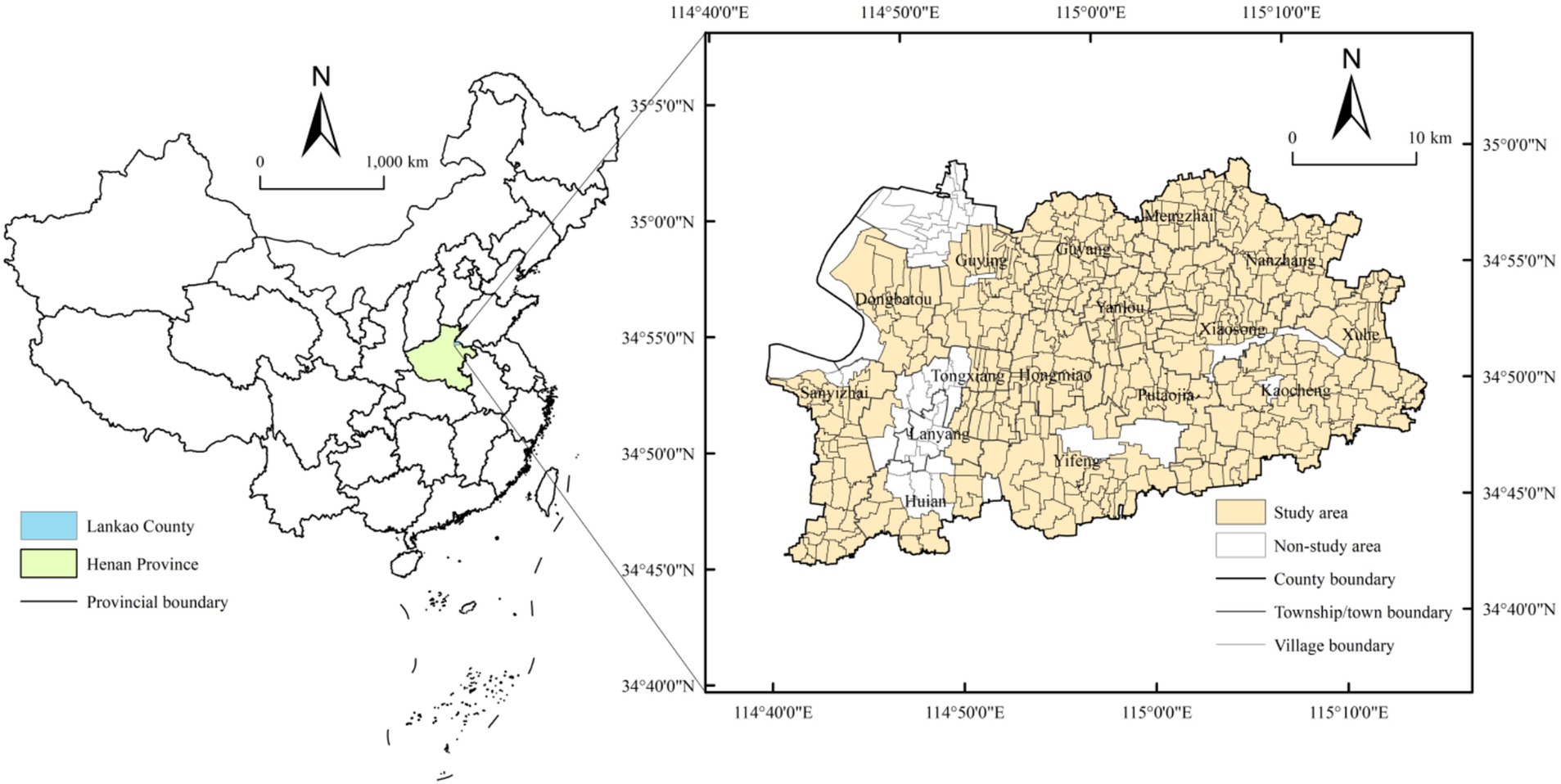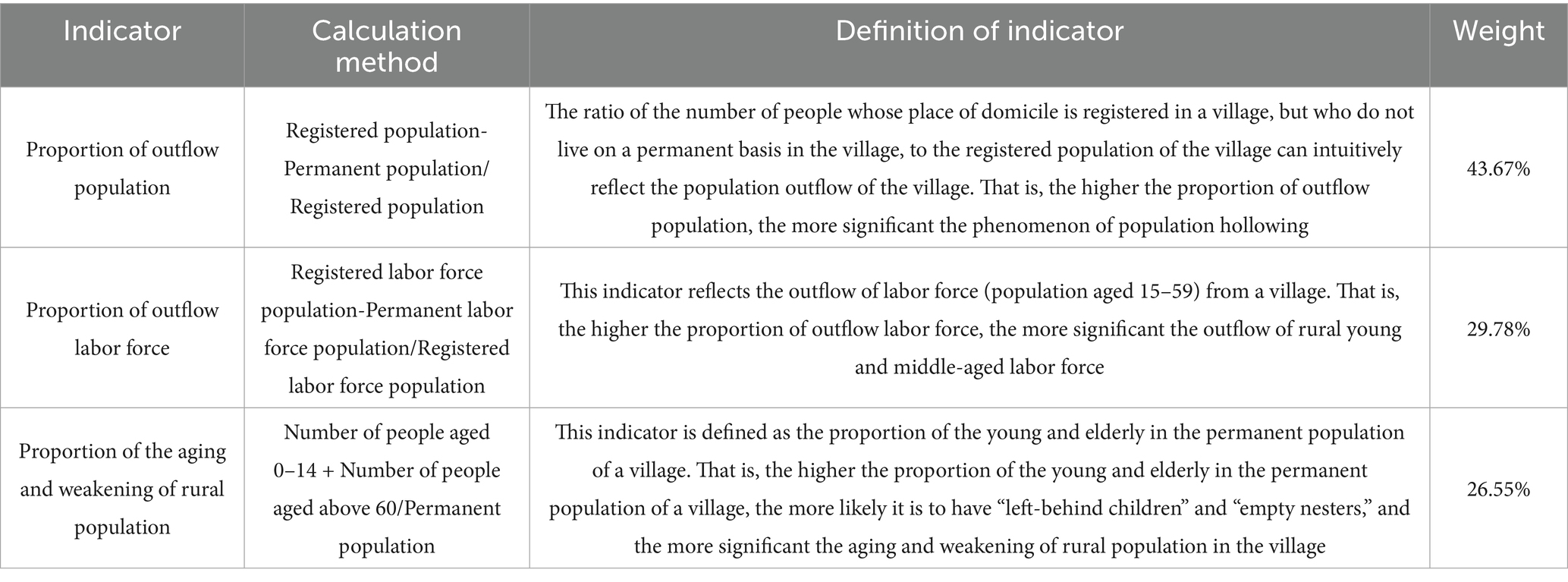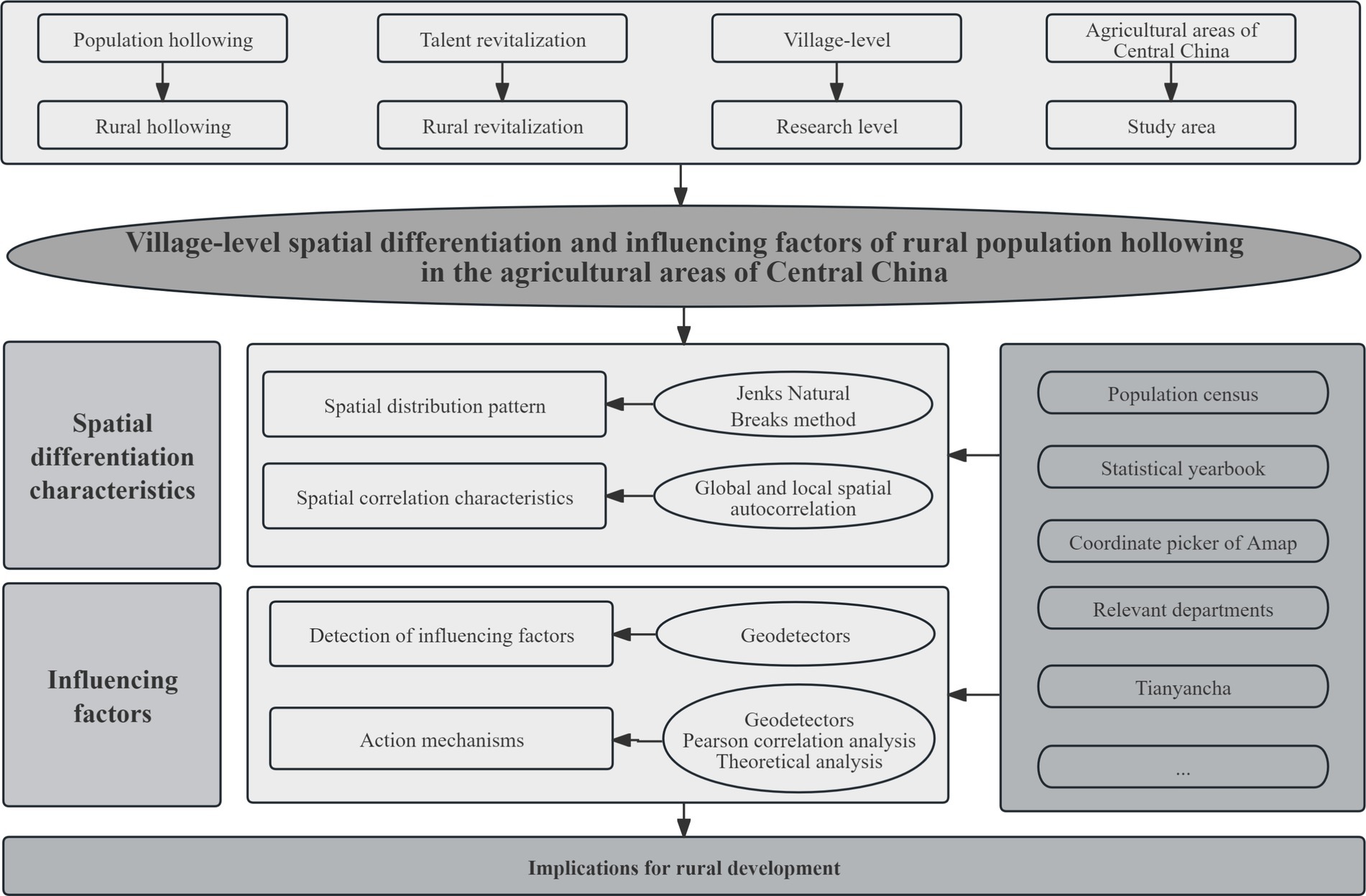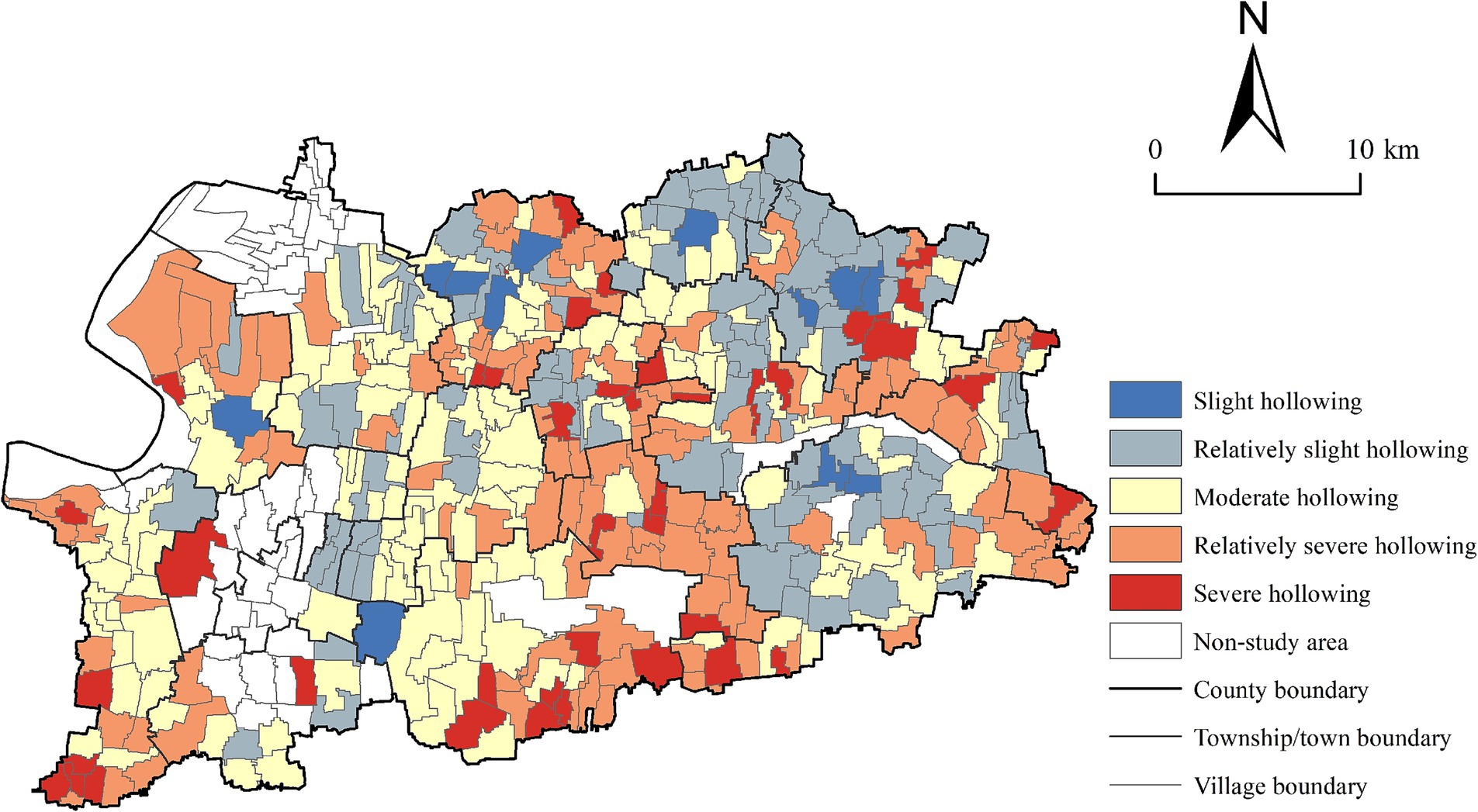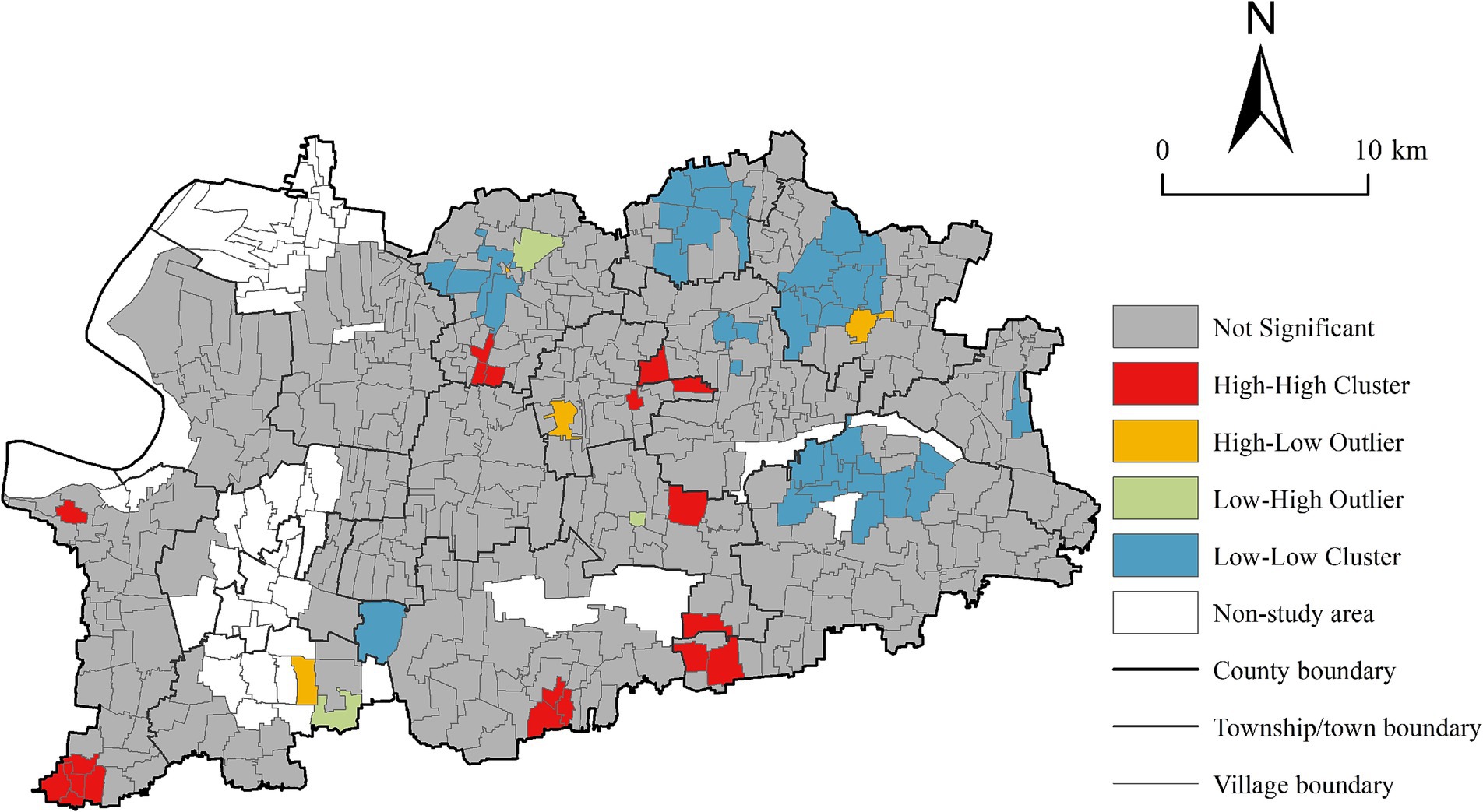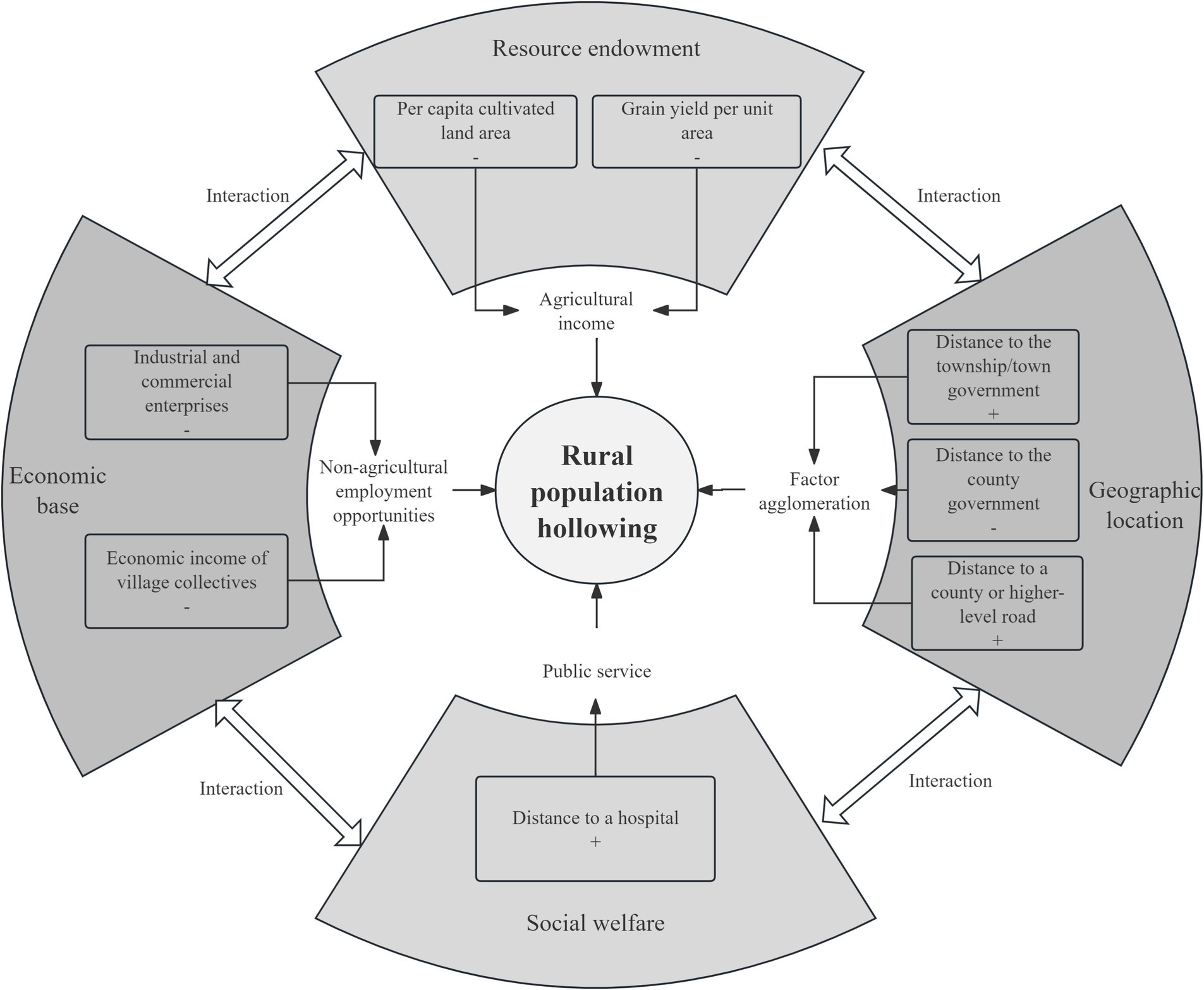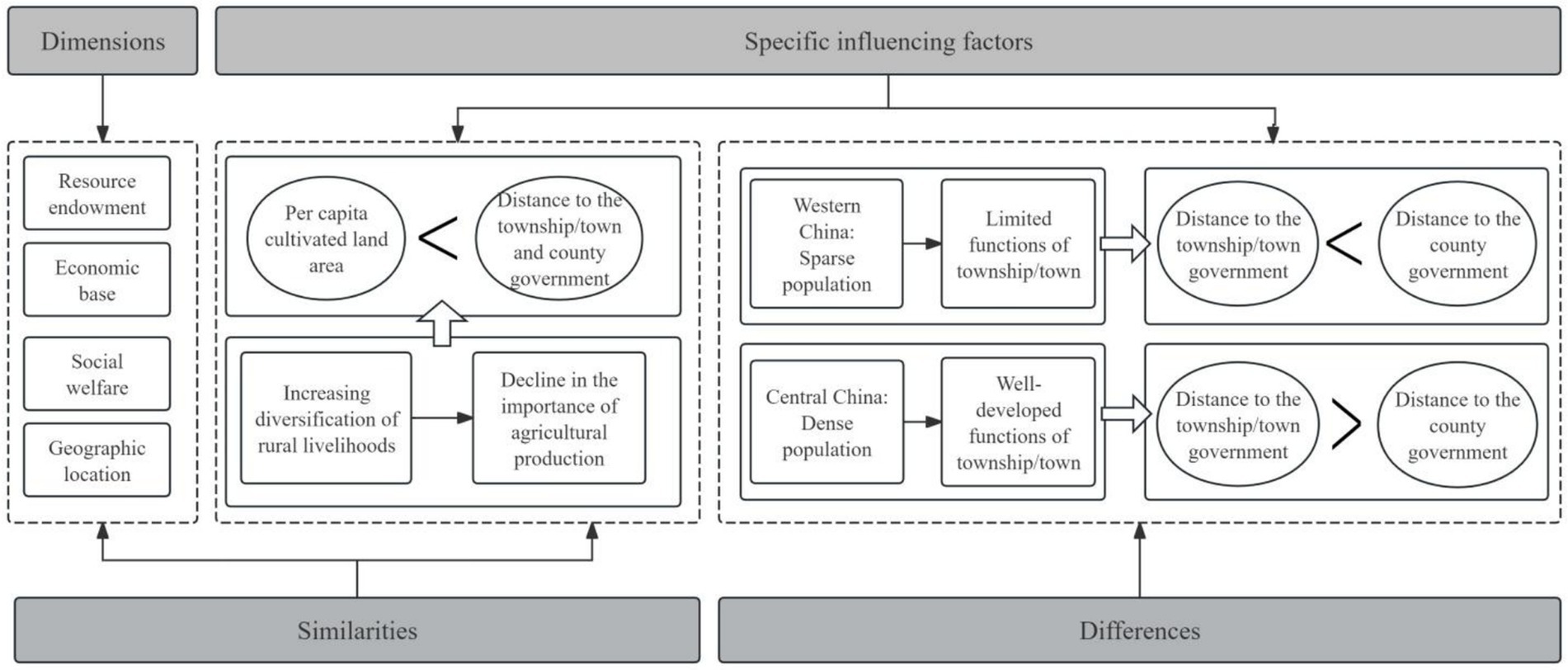- 1Faculty of Geographical Science and Engineering, Henan University, Zhengzhou, China
- 2School of Tourism, Xinyang Normal University, Xinyang, China
- 3School of Public Administration, Xi’an University of Architecture and Technology, Xi’an, China
Rural hollowing is a manifestation of rural decline under rapid urbanization and industrialization, with population hollowing at its core. While most existing studies have been conducted at the county level, the relatively few village-level studies have mainly focused on Western and Northeastern China. In contrast, the densely populated villages of Central China, which are characterized by limited per capita cultivated land, have received comparatively less scholarly attention. Focusing on Lankao County—a representative agricultural region in Central China—this study integrates village-level geospatial and socio-economic data to investigate the spatial differentiation and influencing factors of rural population hollowing, employing spatial analysis and geodetectors. The findings show that: (1) Villages in Lankao County had a generally high population hollowing index (PHI), with a spatial distribution pattern characterized by higher values in the southwest and lower ones in the northeast. (2) The population hollowing levels of villages in Lankao County showed a significant positive spatial autocorrelation at the global level. The local spatial autocorrelation analysis revealed that significant villages predominantly exhibited LL and HH clusters. (3) Some factors have a certain explanatory power for the formation of the spatial distribution pattern of population hollowing in Lankao County in each of the following four dimensions: resource endowment, economic base, social welfare, and geographic location. Moreover, when any two factors interact, their explanatory power for the spatial distribution of population hollowing is enhanced. (4) Resource endowment, economic base, and social welfare determine the complementarity between villages and the outside world, while geographic location affects the accessibility between them. This study not only addresses the limitations of existing village-level research on rural population hollowing but also enriches the diversity of study areas, offering valuable insights for mitigating rural population outflow and promoting sustainable development in similar agricultural regions.
1 Introduction
Amid the global processes of urbanization and industrialization, rural decline has become a common challenge faced by rural development worldwide (Liu et al., 2010; Lasanta et al., 2017). In response to rural challenges such as population decline, low agricultural efficiency, and reduced sustainability, most countries around the world have implemented corresponding rural planning and practical measures. Examples include Germany’s regulatory policy for land consolidation (Hendricks and Lisec, 2014), Britain’s agricultural intensification reform (Posthumus and Morris, 2010), Japan’s “Village Merger and Resettlement” policy and “One Village, One Product” campaign (Long et al., 2008; Noble, 2019), and South Korea’s “New Village Movement” (Doucette and Müller, 2016). Since its reform and opening-up in 1978, China has experienced the largest and fastest process of urbanization and industrialization in world history, making remarkable achievements that have attracted worldwide attention. However, due to the long-standing presence of an urban–rural dual structure system, as well as the policy inclinations of “prioritizing cities at the expense of rural areas” and “agriculture nurturing industry,” rural development has long been disadvantaged. In the process of rapid urbanization and industrialization, rural labor, land, capital, and other factors have flowed unilaterally to cities and towns on an unprecedented scale (Du and Liu, 2021). This triggered a severe phenomenon of rural hollowing, which is mainly characterized by population outflow, land abandonment, housing vacancy, and industry decline (Liu et al., 2009). Imbalanced urban–rural development and inadequate rural development have become the major challenges faced by China’s social and economic development at the present stage. It should be noted that, as people are the most active production factor and play a key role in rural construction, population outflow is the direct cause of the massive outflow of production factors in rural areas; thus, population hollowing is the main indicator of rural hollowing. This phenomenon is mainly manifested in the massive outflow of young and middle-aged labor force, which leads to problems such as reduced rural population, aging and weakening of rural population, and declining population quality (Yang et al., 2013). According to data from the Seventh National Population Census of China, compared to the year 2010, the year 2020 witnessed a decrease in rural population by 164 million (24.38%) and an increase in the number of migrant workers by approximately 43.37 million (17.90%) (Zhang et al., 2024). At present, China is vigorously promoting a strategy of rural revitalization, as the premise of achieving rural industrial, organizational, cultural, and ecological revitalization lies in retaining work force and attracting talents. In this sense, understanding the spatial differentiation of rural population hollowing and its causes can help scientifically classify village types and formulate place-based development strategies, thereby effectively mitigating rural population outflow and promoting the high-quality operation of rural regional systems.
Geographers have conducted extensive research on the measurement and driving factors of rural population hollowing and the development of targeted countermeasures. Specifically, in terms of measurement, the majority of scholars used regional population outflow to characterize the degree of population hollowing (Wang et al., 2021; Wen et al., 2023). Some studies also combined this with the proportion of non-labor force groups, such as the elderly and children, to comprehensively measure the degree of population hollowing (Zheng et al., 2019; Du et al., 2022). Several measures were also employed to assess the degree of population hollowing, such as the rate of rural-to-urban migration, the degree of population agglomeration, and the centrality of population (Yang et al., 2012; Tan et al., 2017). With the development of information technology, some scholars have gradually introduced location-based services (LBS) big data to characterize labor mobility and, thus, measure the degree of population hollowing (Wang et al., 2024). In terms of driving factors, the formation and development of rural population hollowing are affected by multiple factors. At a macro level, urbanization and industrialization are two important causes of rural population hollowing (Liu et al., 2010; Wirth et al., 2016; Zhang et al., 2019). In particular, in China, the urban–rural dual structure, based on the household registration system, has aggravated urban–rural development disparities, driving rural population to cities (Liu, 2018). At the level of specific study areas, factors such as regional resource endowment, geographic location, and socio-economic conditions significantly affect local rural hollowing (Cui et al., 2011; Sorensen, 2018; Fu et al., 2024). In terms of countermeasures, the problem of rural hollowing can be effectively solved, e.g., by reforming the land system, improving social security and infrastructure, restoring the ecological environment, and pushing industrial diversification (Li et al., 2014; Tietjen and Jorgensen, 2016; Zhang et al., 2024). In relation to the research level, existing studies mostly focused on the county level, or took individual villages as the case study area. However, since counties encompass both urban and rural sectors, county-level studies cannot truly reflect the current situation of rural population hollowing. In cases where an individual village is taken as the case study area, it is difficult to directly identify the micro-spatial differentiation characteristics of rural population hollowing, not to mention to effectively supporting the implementation of policies for rural hollowing governance. Meanwhile, as the basic unit of socio-economic activities in rural China, villages serve as the key entry point for addressing rural development challenges and represent the main platform for implementing the rural revitalization strategy (Li et al., 2012). Therefore, it is particularly necessary to conduct micro-scale studies with villages as the basic unit of analysis. For China, which faces a pronounced, complex, and widespread situation of rural population hollowing (Liu et al., 2010), only a few village-level studies have been conducted, which mainly focused on rural areas in Western and Northeastern China (Zheng et al., 2019; Du et al., 2022; Wen et al., 2023). These regions are generally characterized by vast land areas and low population density, exhibiting distinct agricultural patterns. The western region features a mixed farming-pastoral system shaped by its ecologically diverse terrain, while the northeastern region is dominated by large-scale, mechanized agriculture across expansive fertile plains. In contrast, Central China is densely populated and plays a key role in national grain production. Its agricultural areas are typically characterized by a large population base, limited per capita cultivated land, a high proportion of migrant workers, and significant population outflow (Liu and Long, 2016; Tong et al., 2022). In this context, investigating the population hollowing at the village level in Central China’s agricultural areas seems to be especially necessary.
On this basis, this paper takes Lankao County of Henan Province in Central China as a case study to analyze the spatial differentiation characteristics of population hollowing at the village level, and explore the factors influencing the spatial differentiation of population hollowing. The purpose of this paper is to enrich existing geographic research on population hollowing at the micro-scale of villages, providing scientific references to solve the problem of population hollowing and promote sustainable rural development. This paper is organized as follows. Section 2 introduces the study area, the research methods, and the data sources. Section 3 analyzes the results. Section 4 presents the discussion, and Section 5 provides the conclusions.
2 Research methods and data sources
2.1 Overview of the study area
In this paper, Lankao County of Henan Province in Central China was taken as the study area (Figure 1). Located in Central China and in the middle and lower reaches of the Yellow River, Henan Province is known as the “Granary of the Central Plains.” As a major agricultural province, Henan produces 1/10 of total national grain production covering 1/16 of the country’s total cultivated land, thus bearing the significant burden of ensuring national grain security. In 2020, Henan Province had a permanent population of 99.37 million and a net population outflow of 14.83 million, ranking first in the country. Its urbanization rate was 55.43%, ranking fifth from the bottom among Chinese provinces and far lower than the average level (63.89%). Lankao County is located in the northeast of Henan Province and on the Eastern Henan Plain, and has a total land area of 1,103.25 km2. In 2020, Lankao County had a permanent population of 777,300 (364,400 urban population and 412,900 rural population), and its urbanization rate was 46.88%, which was lower than the average level of Henan Province and of the country at large. As a typical agricultural county in Central China, Lankao County is rich in agricultural product resources, and strives to advance the high-quality development of agriculture. It has won the titles of “National Commercial Grain Production Base,” “National Pilot Zone for Green Agricultural Development,” “National Demonstration Zone for Agricultural Modernization,” and “National Demonstration County for Rural Revitalization,” among others. However, similar to the majority of agricultural areas of Central China, Lankao County also faces the problems of a low level of per capita cultivated land resources, a large number of migrant workers, and serious population outflow. Compared to the year 2010, the year 2020 saw a decrease in rural population by 88,500 in Lankao County, which has led to “empty nesting,” population aging, and other issues. All these factors have turned Lankao County into an important window through which we can explore the characteristics and influencing factors of the population hollowing of villages in the agricultural areas of Central China. Lankao County has jurisdiction over five townships, eight towns, three subdistricts, and 454 villages (communities). For the purpose of this study, we excluded 22 communities and 18 relocated villages. It is worth noting that Kaocheng Town is a sub-center town of Lankao County, and that Zhangnan Village, a village where the town government is located, has clear urban characteristics, and was therefore excluded from this study. Ultimately, the remaining 413 villages in Lankao County were taken as the research objects.
2.2 Research methods
2.2.1 Measurement of the population hollowing index (PHI)
Rural population outflow is obviously age-selective. The massive outflow of labor force (mainly young and middle-aged labor force) for non-agricultural activities has accelerated the aging and weakening of rural population, including population juvenilization and population aging (Zou and Wu, 2013). In this context, by referring to existing literature (Wang et al., 2017; Zheng et al., 2019), this paper selected three indicators to measure the degree of the population hollowing at the village level. These indicators include the proportion of outflow population, the proportion of outflow labor force, and the proportion of people aged 0–14 and above 60. The study combines an objective weighting method (the entropy weight method) and a subjective weighting method (the Analytic Hierarchy Process, AHP) to determine the composite weights of the indicators. This approach balances the objectivity of data with the subjectivity of expert judgment, ensuring the scientific validity and rationality of the weight assignment. Specifically, the entropy weight method calculates each indicator’s weight according to its degree of variation, assigning greater weight to indicators with higher variability, as these are deemed to provide more significant informational value (Ou et al., 2008). For the subjective component, the AHP method constructs a judgment matrix based on the scores from three domain experts, calculates the indicator weights, and performs a consistency test, with a consistency ratio (CR) below 0.1, indicating satisfactory reliability (Wang et al., 2017). Finally, the weights obtained from both methods are averaged equally to produce the composite weights of the indicators (Table 1). Subsequently, the village PHI was calculated as follows:
where denotes the PHI of the th village unit, whereby the greater the value of PHI, the higher the level of population hollowing; denotes the normalized value of the th indicator of the th village unit; and denotes the weight of indicator , which is the average value of the weights calculated using the AHP and the entropy method.
2.2.2 Influencing factors of population hollowing
2.2.2.1 Geodetectors
Geodetectors are a statistical method to detect the driving factors behind spatial differentiation (Wang and Xu, 2017). Relying on the single-factor detection and two-factor interactive detection functions of geodetectors, this study identified the factors influencing the spatial differentiation of the population hollowing of villages in Lankao County, and explored the interactions between them. The equation employed is as follows:
where q denotes the explanatory power of an influencing factor for the spatial distribution of population hollowing levels across villages, that is, the greater the value of q, the stronger the explanatory power of the influencing factor, and vice versa; h = 1, …, S denotes the stratification of influencing factor X; N and Nh denote the number of village units in the whole county and layer h, respectively; and denote the variances of the population hollowing levels of the whole county and layer h, respectively. In addition, the specific types of interactions are identified by comparing the values of q(Xa), q(Xb), and q(Xa∩Xb) (Table 2).
2.2.2.2 Indicator selection
Urban–rural development disparities constitute the root cause of rural population hollowing. The long-standing presence of an urban–rural dual structure and the policy inclinations of “prioritizing cities at the expense of rural areas” and “agriculture nurturing industry” have long kept rural areas at a developmental disadvantage, forcing rural population to migrate to cities on a massive scale. At the village level, differences in the development conditions of villages directly determine the magnitude of urban–rural development disparities, and correspondingly affect the degree of population hollowing. Referring to the findings of existing studies in this field (Chen et al., 2018; Zheng et al., 2019; Wen et al., 2023; Zhu et al., 2024), this study comprehensively considered the scientific validity, data accessibility, and the actual conditions of the study area in the selection of indicators. Based on this, an indicator system was constructed to identify the factors influencing village-level population hollowing, covering four dimensions: resource endowment, economic base, social welfare, and geographic location (Table 3).
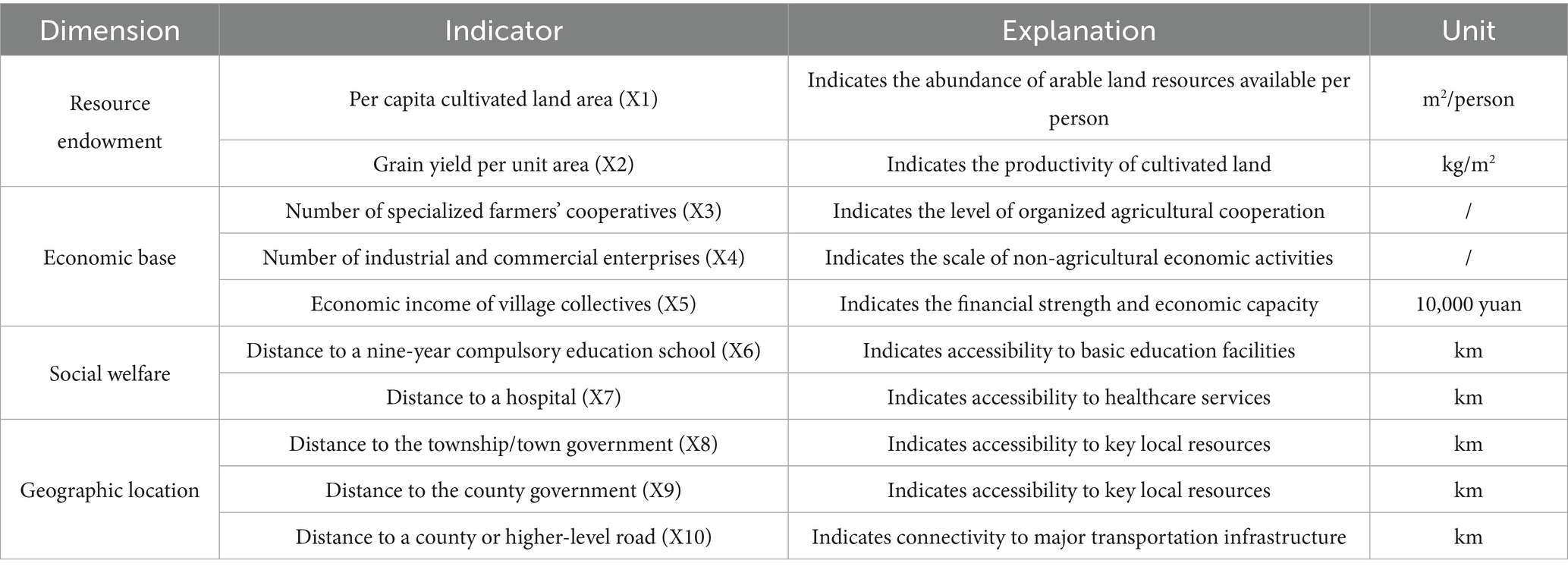
Table 3. Indicator system for the factors influencing the population hollowing of villages in Lankao County.
2.3 Data sources
The research year of this study is 2020. The data on the permanent population of villages were taken from the Seventh National Population Census of China. The data on registered population were extracted from the Statistical Yearbook of Lankao County. The land use data on cultivated land area (with a spatial resolution of 30 m) was excerpted from the Geographical Information Monitoring Cloud Platform.1 The data on the income of village collectives came from the Bureau of Agriculture and Rural Affairs of Lankao County. The data on the number of industrial and commercial enterprises and specialized farmers’ cooperatives were abstracted from Tianyancha.2 The data on the geographical coordinates of village committees, schools, hospitals, township/town governments, county government, and so forth were taken from the Coordinate Picker of Amap. The data on county or higher-level roads were sourced from the National Geomatics Center of China (NGCC, http://www.ngcc.cn/), and the straight-line distances from village committees to schools, hospitals, township/town governments, the county government, and county or higher-level roads were calculated on this basis using ArcGIS.
Figure 2 illustrates the research framework of this study, including the research background, research content, method and data sources.
3 Results
3.1 Spatial differentiation characteristics of the population hollowing of villages
3.1.1 Spatial distribution pattern
The PHI values of 413 villages in Lankao County were calculated using Equation 1. Based on these values, the villages were then divided into five grades of population hollowing using the Jenks Natural Breaks method, namely “severe hollowing,” “relatively severe hollowing,” “moderate hollowing,” “relatively slight hollowing,” and “slight hollowing.” The results were spatially visualized using ArcGIS (Figure 3).
Villages in Lankao County were found to have a generally high PHI, with a basic spatial distribution pattern characterized by higher values in the southwest and lower values in the northeast. Statistically, the population hollowing level of villages in Lankao County ranged between 0.24 and 0.95, with an average value of 0.64. The proportions of severely hollowed, relatively severely hollowed, moderately hollowed, relatively slightly hollowed, and slightly hollowed villages were 10.17, 28.33, 34.87, 23.73, and 2.91%, respectively. Clearly, villages with moderate hollowing and relatively severe hollowing played dominant roles. In terms of spatial distribution, villages with slight and relatively slight hollowing were mainly located in townships/towns at the eastern or northern edges of Lankao County, such as Kaocheng Town, Nanzhang Town, Mengzhai Township, Xiaosong Town, each with at least ten villages of each type. In addition, it is worth noting that there were still a few villages with slight and relatively slight hollowing that were distributed around the county, such as Wuyuemiao Village and Niuwangmiao Village in Lanyang Sub-district, Zhuchang Village in Guying Town, and Cailou Village in Sanyizhai Township. The townships/towns in the west or south of Lankao County, such as Putaojia Township, Sanyizhai Township, and Yifeng Town, included a large number of villages with severe hollowing and relatively severe hollowing. The three townships/towns, with average PHI values of 0.70, 0.68, and 0.67, ranked among the top three in the county. Villages with moderate hollowing, on the other hand, were widely distributed across all townships/towns.
3.1.2 Spatial correlation characteristics
Both global and local spatial autocorrelation analyses were performed on the PHI values of villages in Lankao County using the Global Moran’s I and the Local Moran’s I. The purpose was to analyze the overall spatial correlation and the specific spatial correlation patterns of population hollowing. In the global spatial autocorrelation analysis, Moran’s I value was 0.29, and the p value was 0.00 (p < 0.01). These results show that overall, the population hollowing levels of villages in Lankao County had a significant positive spatial correlation. That is, villages with similar population hollowing levels tended to show spatial agglomeration, meaning that those with similarly high/low population hollowing levels were more likely to form relatively concentrated clusters. Furthermore, specific spatial correlation patterns and locations were identified based on local spatial autocorrelation analysis. Accordingly, 63 villages were significantly identified. They could be further divided into High-High (HH) and Low-Low (LL) clusters, indicating villages with similarly high or low PHI values grouped together, and into High-Low (HL) and Low-High (LH) outliers, indicating villages where high PHI values are surrounded by low ones or vice versa (Figure 4). The LL and HH clusters accounted for 58.73 and 30.16% of the significant villages, respectively. As shown in Figure 4, four large-scale LL clusters have emerged in the township/towns located in the eastern or northern parts of Lankao County (i.e., Kaocheng Town, Nanzhang Town, Mengzhai Township, and Guyang Town), with each cluster containing eight villages on average. What is noteworthy is that these four large-scale LL clusters were mainly composed of those villages where the township/town governments are located and some nearby villages. HH clusters often had a relatively small scale. The largest HH cluster, located in Sanyizhai Township in the west of Lankao County, was composed of only five villages, while the others were mainly distributed in the central or southern parts of the county.
3.2 Influencing factors
3.2.1 Detection of influencing factors
The ten influencing factors were divided into five equal parts using SPSS software. According to Equation 2, geodetectors were used to quantitatively measure the explanatory power (q value) of each influencing factor for the spatial distribution of population hollowing levels, while the interactive detection modules of geodetectors were employed to explore the interactions between influencing factors.
It can be seen from Table 4 that the influencing factors can be ranked as follows, in the descending order of their explanatory power (q value): X7 > X4 > X8 > X10 > X9 > X1 > X2 > X5 > X3 > X6. This result suggests that there are five key driving factors for the formation of the spatial distribution pattern of population hollowing in Lankao County, namely, the distance to a hospital, the number of industrial and commercial enterprises, the distance to the township/town government, the distance to a county or higher-level road, and the distance to the county government. These five key driving factors had relatively large q values, and passed the 1% significance level test. Next, per capita cultivated land area, grain yield per unit area, and the economic incomes of village collectives were found to play important roles in the formation of the spatial distribution pattern of population hollowing, as they passed significance tests at either the 1% or 10% level. In contrast, the number of specialized farmers’ cooperatives and the distance to a nine-year compulsory education school were found to have a weak explanatory power, and failed the significance level test. Overall, some factors were found to have some explanatory power on the formation of the spatial distribution pattern of population hollowing in Lankao County in each of the four dimensions. Notably, all the factors in the dimensions of geographic location and resource endowment passed the significance level test. Looking at the interactions between influencing factors (Figure 5), it was found that, when any two factors interacted, the explanatory power for the spatial distribution of population hollowing was enhanced, and was stronger than the explanatory power when either of them was acting alone. More specifically, 86.67% of factor pairs showed nonlinear enhancement (meaning that the interaction result was “1 + 1 > 2”), while 13.33% of factor pairs manifested bivariate enhancement (meaning that the interaction result was greater than the larger one of the q values of the two factors). From the perspective of q values after interactions, larger q values mainly appeared in the interaction analysis between key driving factors (such as X7, X4, and X8) and other factors.

Table 4. Detection results of the factors influencing population hollowing of villages in Lankao County.
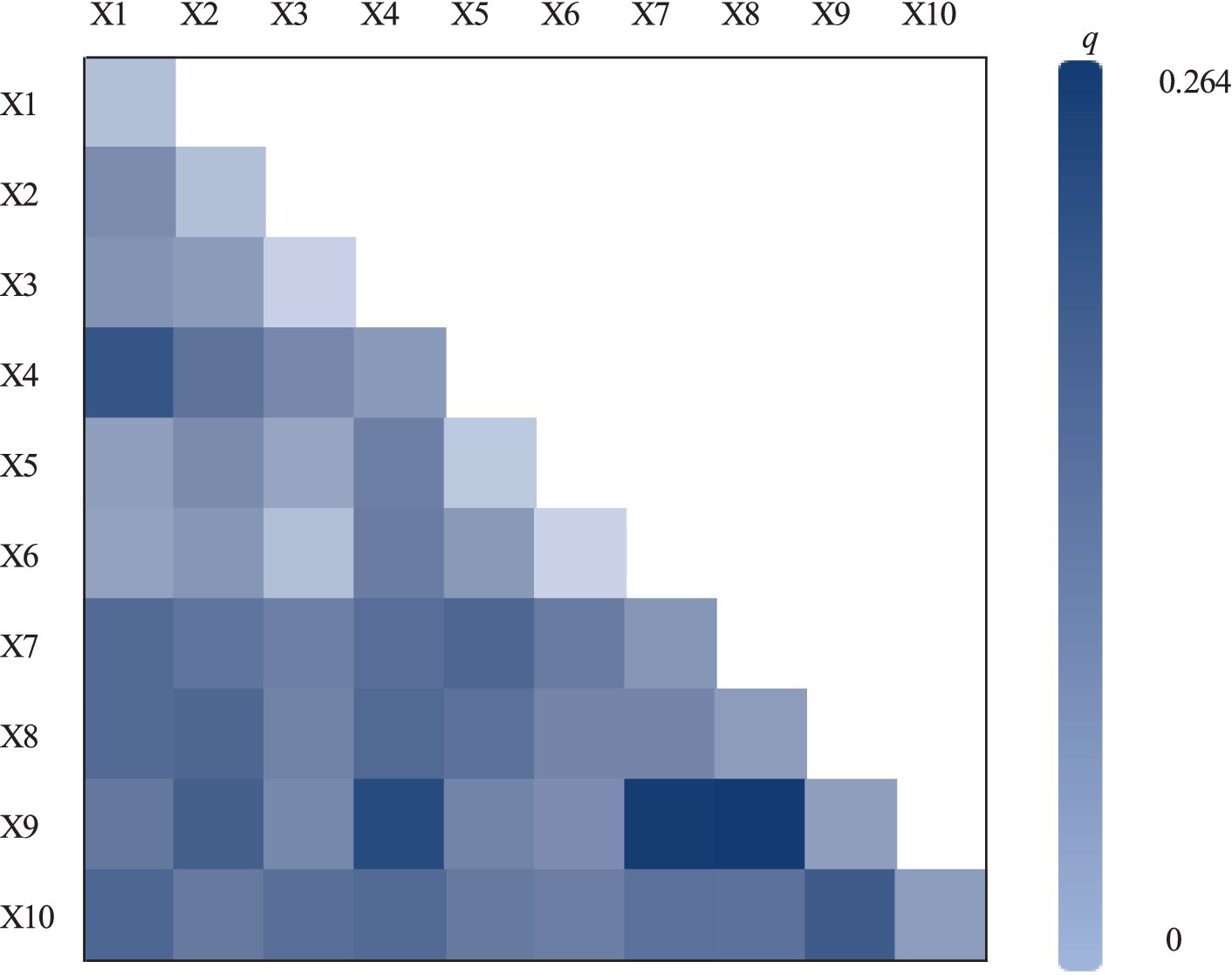
Figure 5. Detection results of the interactions between the factors influencing population hollowing of villages in Lankao County.
3.2.2 Action mechanisms
Based on the results of the analysis of geodetectors, the population hollowing of villages was found to be affected by multiple factors. To compensate for the fact that geodetectors cannot detect the positive or negative impacts of the influencing factors, this study further clarified the direction of influence of each factor through Pearson correlation analysis (Hu et al., 2019; Xia et al., 2020). On this basis, we examined the mechanisms through which factors of different dimensions affect the regional differentiation of the degree of population hollowing (Figure 6). In the figure, a plus sign (+) indicates a positive impact, while a minus sign (−) denotes a negative impact.
In terms of resource endowment, both per capita cultivated land area and grain yield per unit area were found to have negative impacts on the degree of population hollowing. In other words, villages with lower per capita cultivated land area and lower grain yield per unit area tend to experience more severe population hollowing. The reason is that low per capita cultivated land area and grain yield per unit area limit the scale and economic benefits of agricultural production (Ma et al., 2019). This makes it difficult for families to earn an agricultural income that can meet their economic needs, and forces rural residents (especially young and middle-aged laborers) to migrate to cities for better economic opportunities and living conditions. This, in turn, aggravates the aging and weakening of rural population, resulting in a worsening of population hollowing.
In terms of economic base, the number of industrial and commercial enterprises and the economic income of village collectives were found to have negative impacts on the degree of population hollowing. This is because villages with a greater number of industrial and commercial enterprises can provide more non-agricultural employment opportunities for villagers and reduce their needs for migration (Liu et al., 2024). These enterprises may even attract migrants to live and work on a long-term basis. As a result, the degree of population hollowing can be effectively reduced. Villages with higher collective economic income can provide funds, technology, facilities, and other support for the diversified development of rural economic structure, which is conducive to creating a favorable entrepreneurial environment and promoting villagers to find more development opportunities in other non-agricultural industries, thus reducing population outflow (Fan and Yin, 2024). However, the majority of specialized farmer cooperatives in Lankao County still focus on agricultural activities such as planting and breeding. They have failed to either effectively expand into non-agricultural industries with higher added value or fully play their role in extending agricultural industrial and value chains and providing high-paying jobs (Cheng et al., 2025). As a result, rural residents still tend to migrate to cities for better economic opportunities. This explains why the number of specialized farmers’ cooperatives was not found to have a significant impact on the degree of population hollowing.
In terms of social welfare, the distance from a village to a hospital was found to have a positive impact on its degree of population hollowing, that is, the larger the distance from a village to a hospital, the higher the degree of population hollowing. The reason is that, with the improvement of people’s health awareness and increasing population aging, rural residents’ demand for medical services has obviously increased; in this case, the lack of medical conditions will increase their motivation to migrate (Wang et al., 2023). In contrast, in the case of Lankao County, the full implementation of nine-year compulsory education has led to the relatively even distribution of compulsory education resources. For this reason, the distance to a nine-year compulsory education school was found not to have a significant impact on the population hollowing of villages.
In terms of geographic location, the distance to the township/town government and the distance to a county or higher-level road were found to have a positive impact on the degree of population hollowing. This is because township/town governments and arterial roads are often surrounded by the clusters of multiple factors, and can attract all kinds of social services, investment, and industrial projects, as well as provide complete infrastructure, public service facilities, and abundant employment opportunities (Li et al., 2024). This is conducive to improving the quality of life and economic conditions of nearby residents. Accordingly, these have a stronger appeal, and can effectively mitigate the trend of population hollowing. However, in the case of Lankao County, the county government is located in the southwest of the county, and, although it has a strong ability to gather multiple factors, its radiating capacity still obeys the law of geographic attenuation. For this reason, the residents of villages in the northeast of the county have a low willingness to migrate, while their dependence on local resources is enhanced, which consequently alleviates population outflow. On the whole, the distance to the county government was found to have a negative impact on the degree of population hollowing.
In general, according to the theory of spatial interactions, there is the mutual transfer of manpower, materials, energy, information, and other factors between regions, mainly because of the presence of complementarity, accessibility, and intermediary opportunities (Ullman, 1957). By analogy, rural population hollowing is actually a result of urban–rural population mobility. A village’s resource endowment determines residents’ basic willingness to engage in agricultural production, while its economic base affects their opportunities for non-agricultural employment. In addition, its social welfare conditions influence residents’ access to public services. These three dimensions affect the difference, that is, the complementarity, between the village and the outside world. Geographic location, on the other hand, determines the ease of contact between the village and the outside world, i.e., accessibility. Under the current background of urban–rural integration, various policies are encouraging and promoting the two-way flow of factors, and the related channels are becoming increasingly smooth. Accordingly, the impact of intermediary opportunities is relatively weak.
4 Discussion
4.1 Analysis of influencing factors
Figure 7 illustrates the similarities and differences between this study and previous research regarding the influencing factors of rural population hollowing.
Consistent with previous research findings across county, village, and household levels (Cui et al., 2011; Zheng et al., 2019; Wang et al., 2021; Wen et al., 2023; Fu et al., 2024), this study confirms that resource endowment, economic base, social welfare, and geographic location significantly influence rural depopulation processes. Regarding specific influencing factors, similar to the studies by Zheng et al. (2019) and Wen et al. (2023) in the counties of Western China, this study also confirms the significant impact of per capita cultivated land area, distance to the township/town and county government on rural depopulation. And, the explanatory power of cultivated land is weaker than that of geographic accessibility factors. The underlying reasons may lie in the fact that, with the increasing diversification of rural livelihoods, the importance of agricultural production benefits derived from cultivated land is gradually declining, along with its influence on population distribution. In contrast, better access to employment opportunities, education, healthcare and other services associated with favorable geographic locations has become more attractive to rural residents, especially young people, and now plays a dominant role in affecting their decisions on employment and migration.
Notably, this study reveals significant regional disparities. In the sparsely populated counties of Western China examined by Zheng et al. (2019) and Wen et al. (2023), with permanent population densities of 72.36 and 18.68 persons/km2, respectively, the impact of villages’ distance to the county government on rural depopulation was greater than their distance to the township/town government. In contrast, our Central China case study—Lankao County (permanent population density: 704.53 persons/km2)—exhibited the opposite pattern. This regional divergence may be attributed to the fact that, in densely populated central agricultural regions, townships/towns as secondary growth poles have developed relatively strong capacities for absorbing non-agricultural employment and providing public services. The effect of population concentration is significant, and their role as nodes in spatial governance has become increasingly prominent, thereby facilitating the formation of a multi-level, networked development pattern linking counties, townships/towns, and villages. Conversely, in the sparsely populated western regions, townships/towns demonstrate relatively weakened functionality with limited population concentration capacity, and counties exert a stronger influence on population outflow from villages. This finding underscores the academic value of focusing on Central China agricultural areas and addresses a gap in the existing literature regarding regional typologies.
4.2 Implications for rural development
Amid China’s comprehensive push for rural revitalization, rural development has become a national priority. However, the persistent problem of population hollowing poses serious challenges. It not only leads to labor force outflow and a decline in agricultural productivity, but also weakens the social and cultural vitality of rural areas, degrades the rural ecological environment, and may even trigger social instability. Collectively, these issues hinder the achievement of sustainable rural development. In view of this problem, we would like to call for attention on the following implications stemming from the findings of this paper: (1) By accelerating land transfer to promote large-scale land management, local governments and village collectives can help address the issue of farmland abandonment after the outflow of rural residents. This approach can also help improve the fragmented and inefficient small-scale farming systems resulting from limited per capita arable land resources. Moreover, under the guidance of local authorities, specialized farmers’ cooperatives and farmers can work together to optimize the planting structure, adopt modern agricultural technologies, and develop ecological agriculture, thereby improving land productivity (Wen et al., 2023). (2) Specialized farmers’ cooperatives may consider diversifying beyond basic agricultural production (i.e., planting and breeding) into value-added processing and marketing activities. This transition could allow them to better participate in extending agricultural value chains, potentially enhancing both market competitiveness and employment generation capacity (Cheng et al., 2025). Government guidance and market mechanisms can be combined with the local industrial base to attract external capital and technology, introduce small and medium-sized enterprises (especially those in the processing, rural tourism, and cultural and creative industries), and stimulate their vitality, thus yielding an industrial agglomeration effect. Efforts should also be made to strengthen the economic organization, management, and operation abilities of village collectives, optimize the allocation of village collective resources, improve their operation efficiency, as well as innovate the development model and expand village collective economy (Yi et al., 2023). (3) In response to rural population mobility characteristics, local governments should rationally allocate healthcare resources, optimize the spatial distribution of rural medical institutions, and enhance the capacity and service efficiency of county-level healthcare systems. At the same time, local governments should improve the eldercare service system by upgrading township facilities, taking into account actual village population conditions, and utilizing village-level spaces to promote mutual-aid eldercare models and provide meal assistance and basic daily care for the elderly. (4) Local governments should provide reasonable economic compensation or welfare policies to encourage relocated residents to withdraw from rural homesteads, so as to reasonably properly manage the withdrawn homesteads and improve the utilization efficiency of land resources (Long et al., 2011). (5) Local governments and relevant institutions should strengthen vocational education and skill training to enhance farmers’ professional ability and innovative consciousness, thereby cultivating pioneers of rural prosperity. Moreover, policy-makers should actively encourage various talents to return to or migrate into rural areas, fully leveraging their accumulated advantages in knowledge, experience, technology, capital, and networks, thus injecting new vitality into rural development.
4.3 Significance and shortcomings
By utilizing geospatial and socio-economic data on villages in Lankao County, Henan Province, this study examines the spatial differentiation characteristics and influencing factors of rural population hollowing. The findings not only provide theoretical support for local governments in identifying high-risk areas of hollowing and scientifically classifying village types, but also offer practical guidance for improving population management, optimizing resource allocation, and formulating place-based rural revitalization strategies. These insights contribute to enhancing the precision of rural governance and promoting the efficient operation of rural regional systems. Compared with previous studies, this study addresses the limitations of existing research at the micro-scale of villages, providing more fine-grained insights. Taking Lankao County of Henan Province, an agricultural county of Central China, as a case study, this paper enriches the diversity of study areas in population hollowing research, providing a reference for the sustainable development of rural areas in other agricultural counties of Central China. However, it is also important to point out some limitations of this study. Because of the difficulties in obtaining data at the village level, this study performed only a static study based on cross-sectional data, thus failing to capture the spatio-temporal differentiation characteristics of the population hollowing of villages. Similarly, it failed to detect whether there are time-series differences in the impacts of factors along the dimensions of resource endowment, economic base, social welfare, and geographic location on population hollowing, that is, whether the dominant factors change across different hollowing stages. In the future, this study can serve as a foundation for incorporating time-series data to analyze the evolution of rural population hollowing and its reciprocal impacts with the rural socio-economic system and ecological environment. Building on this, predictive models could be employed to identify village-level population trends and formulate more targeted policy recommendations. In addition, field surveys could help obtain finer-grained data to improve the construction of the indicator system.
5 Conclusion
This paper comprehensively measured the degree of population hollowing of villages based on the proportion of outflow population, the proportion of outflow labor force, and the proportion of the aging and weakening of rural population. Moreover, it deeply analyzed the spatial differentiation characteristics of population hollowing at the village level in Lankao County, and, on this basis, used geodetectors to explore the influencing factors behind its spatial differentiation. The main conclusions are as follows.
Villages in Lankao County were found to have a generally high PHI, with an average value of 0.64. Slightly and relatively slightly hollowed villages were mainly located in townships/towns at the eastern or northern edges of Lankao County. The townships/towns in the west or south of Lankao County included a large number of villages with severe hollowing and relatively severe hollowing. Villages with moderate hollowing, on the other hand, were widely distributed across all townships/towns.
The levels of population hollowing of villages in Lankao County showed a significant positive spatial autocorrelation at the global level. The results of the local spatial autocorrelation analysis showed that 63 villages were significantly identified, predominantly exhibited LL and HH clusters. LL clusters were often large in scale, while HH clusters were smaller.
Some factors have a certain explanatory power for the formation of the spatial distribution pattern of population hollowing in Lankao County in each of the following four dimensions: resource endowment, economic base, social welfare, and geographic location. When any two factors interact, the explanatory power for the spatial distribution of population hollowing is enhanced, being stronger than the explanatory power when either of them is acting alone.
A village’s resource endowment determines residents’ basic willingness to engage in agricultural production, while its economic base affects their opportunities for non-agricultural employment. In addition, its social welfare conditions influence residents’ access to public services. These three dimensions affect the difference, that is, the complementarity, between the village and the outside world. Geographic location, on the other hand, determines the ease of contact between the village and the outside world, i.e., accessibility.
Data availability statement
The raw data supporting the conclusions of this article will be made available by the authors, without undue reservation.
Author contributions
LC: Conceptualization, Formal analysis, Methodology, Visualization, Funding acquisition, Investigation, Writing – original draft. XL: Software, Methodology, Writing – original draft, Formal analysis, Visualization, Data curation. LM: Methodology, Writing – review & editing, Data curation, Validation. JQ: Project administration, Validation, Resources, Supervision, Funding acquisition, Conceptualization, Writing – review & editing.
Funding
The author(s) declare that financial support was received for the research and/or publication of this article. This research was funded by the National Natural Science Foundation of China (grant no. 42301239), and the Zhongyuan Leading Innovative Talents Program in Science and Technology (grant no. 254000510057).
Acknowledgments
The authors sincerely thank the reviewers for their valuable comments and suggestions to improve the quality of this paper.
Conflict of interest
The authors declare that the research was conducted in the absence of any commercial or financial relationships that could be construed as a potential conflict of interest.
Generative AI statement
The author(s) declare that no Gen AI was used in the creation of this manuscript.
Publisher’s note
All claims expressed in this article are solely those of the authors and do not necessarily represent those of their affiliated organizations, or those of the publisher, the editors and the reviewers. Any product that may be evaluated in this article, or claim that may be made by its manufacturer, is not guaranteed or endorsed by the publisher.
Footnotes
References
Chen, K., Wang, L., and Li, N. (2018). Rural hollowing out in counties of China: connotation, distribution and formation mechanism. Popul. Econ. 2018, 28–37. doi: 10.3969/j.issn.1000-4149.2018.01.003
Cheng, L., Qiao, J., and Li, X. (2025). Spatiotemporal differentiation and influencing factors of farmers’specialized cooperatives in rural areas of Central China. Econ. Geogr. 45, 153–162. doi: 10.15957/j.cnki.jjdl.2025.02.015
Cui, W., Li, Y., and Liu, Y. (2011). Rural hollowing in key agricultural areas of China: characteristics, mechanisms and countermeasures. Resour. Sci. 33, 2014–2021.
Doucette, J., and Müller, A. R. (2016). Exporting the Saemaul spirit: South Korea’s knowledge sharing program and the ‘rendering technical’ of Korean development. Geoforum 75, 29–39. doi: 10.1016/j.geoforum.2016.06.018
Du, G., Li, N., Wang, J., and Xue, R. (2022). Study on the multidimensional rural hollowing of typical counties in black soil area of Northeast China: a case study of Baiquan county, Heilongjiang Province. Res. Agric. Modern. 43, 1091–1100. doi: 10.13872/j.1000-0275.2022.0096
Du, G., and Liu, M. (2021). A factor-based theoretical analysis of urban-rural relationship change. Prog. Geogr. 40, 1298–1309. doi: 10.18306/dlkxjz.2021.08.004
Fan, S., and Yin, G. (2024). Research on the impact of commercial capital going to the countryside on the returning migrant labors. Chin. J. Agric. Resour. Reg. Plan. Available online at: http://kns.cnki.net/kcms/detail/11.3513.S.20240829.1340.008.html (Accessed December 15, 2024)
Fu, Z., Yang, Y., Wang, L., Zhu, X., Lv, H., and Qiao, J. (2024). Geographical types and driving mechanisms of rural hollowing-out in the Yellow River Basin. Agriculture 14:14030365. doi: 10.3390/agriculture14030365
Hendricks, A., and Lisec, A. (2014). Land consolidation for large-scale infrastructure projects in Germany. Geod. Vestn. 58, 46–68. doi: 10.15292/geodetski-vestnik.2014.01.046-068
Hu, X., Zhang, Z., Chen, X., and Wang, Y. (2019). Geographic detection of spatial-temporal difference and its influencing factors on county economic development: a case study of Gansu province. Geogr. Res. 38, 772–783. doi: 10.11821/dlyj020171169
Lasanta, T., Arnáez, J., Pascual, N., Ruiz-Flaño, P., Errea, M. P., and Lana-Renault, N. (2017). Space-time process and drivers of land abandonment in Europe. Catena 149, 810–823. doi: 10.1016/j.catena.2016.02.024
Li, S., Fang, Y., and Zou, C. (2024). Rural multidimensional development patterns and typological revitalization strategy in semiarid and poverty alleviated areas of Northeast China: taking Tongyu County as an example. Prog. Geogr. 43, 504–516. doi: 10.18306/dlkxjz.2024.03.007
Li, Y., Liu, Y., and Long, H. (2012). Characteristics and mechanism of village transformation development in typical regions of Huang-Huai-Hai plain. Acta Geograph. Sin. 67, 771–782. doi: 10.11821/xb201206005
Li, Y., Liu, Y., Long, H., and Cui, W. (2014). Community-based rural residential land consolidation and allocation can help to revitalize hollowed villages in traditional agricultural areas of China: evidence from Dancheng County, Henan Province. Land Use Policy 39, 188–198. doi: 10.1016/j.landusepol.2014.02.016
Liu, Y. (2018). Research on the urban-rural integration and rural revitalization in the new era in China. Acta Geograph. Sin. 73, 637–650. doi: 10.11821/dlxb201804004
Liu, T., Hong, H., Cai, Z., Yang, S., and Luo, Q. (2024). Regional differences and influencing factors of local employment rates of rural laborers in mountainous and hilly village areas: a case study of 189 villages in Chongqing municipality. Prog. Geogr. 43, 1403–1415. doi: 10.18306/dlkxjz.2024.07.010
Liu, Y., Liu, Y., Chen, Y., and Long, H. (2010). The process and driving forces of rural hollowing in China under rapid urbanization. J. Geogr. Sci. 20, 876–888. doi: 10.1007/s11442-010-0817-2
Liu, Y., Liu, Y., and Zhai, R. (2009). Geographical research and optimizing practice of rural hollowing in China. Acta Geograph. Sin. 64, 1193–1202. doi: 10.11821/xb200910005
Liu, Y., and Long, H. (2016). Land use transitions and their dynamic mechanism: the case of the Huang-Huai-Hai plain. J. Geogr. Sci. 26, 515–530. doi: 10.1007/s11442-016-1283-2
Long, H., Li, Y., Liu, Y., Woods, M., and Zou, J. (2011). Accelerated restructuring in rural China fueled by ‘increasing vs. decreasing balance’ land-use policy for dealing with hollowed villages. Land Use Policy 29, 11–22. doi: 10.1016/j.landusepol.2011.04.003
Long, H., Liu, Y., Wu, X., and Dong, G. (2008). Spatio-temporal dynamic patterns of farmland and rural settlements in Su-xi-Chang region: implications for building a new countryside in coastal China. Land Use Policy 26, 322–333. doi: 10.1016/j.landusepol.2008.04.001
Ma, L., Chen, M., Che, X., and Fang, F. (2019). Farmers’ rural-to-urban migration, influencing factors and development framework: a case study of Sihe Village of Gansu, China. Int. J. Environ. Res. Public Health 16:16050877. doi: 10.3390/ijerph16050877
Noble, V. (2019). Mobilities of the one-product policy from Japan to Thailand: a critical policy study of OVOP and OTOP. Territ. Polit. Gov. 7, 455–473. doi: 10.1080/21622671.2018.1511463
Ou, X., Zhen, F., Qin, Y., Zhu, L., and Wu, H. (2008). Study on compression level and ideal impetus of regional urbanization: the case of Jiangsu Province. Geogr. Res. 27, 993–1002. doi: 10.11821/yj2008050003
Posthumus, H., and Morris, J. (2010). Implications of CAP reform for land management and runoff control in England and Wales. Land Use Policy 27, 42–50. doi: 10.1016/j.landusepol.2008.06.002
Sorensen, J. F. L. (2018). The importance of place-based, internal resources for the population development in small rural communities. J. Rural. Stud. 59, 78–87. doi: 10.1016/j.jrurstud.2018.01.011
Tan, X., Yu, S., Ouyang, Q., Mao, K., He, Y., and Zhou, G. (2017). Assessment and influencing factors of rural hollowing in the rapid urbanization region: a case study of Changsha-Zhuzhou-Xiangtan urban agglomeration. Geogr. Res. 36, 684–694. doi: 10.11821/dlyj201704007
Tietjen, A., and Jorgensen, G. (2016). Translating a wicked problem: a strategic planning approach to rural shrinkage in Denmark. Landsc. Urban Plan. 154, 29–43. doi: 10.1016/j.landurbplan.2016.01.009
Tong, W., Guo, J., Su, F., and Xu, W. (2022). Progress and prospect of the impact of population migration on rural transformation development under the background of rural revitalization. Sci. Geogr. Sin. 42, 662–669. doi: 10.13249/j.cnki.sgs.2022.04.011
Wang, L., Chen, K., and Li, N. (2017). The degree measure and spatial-temporal variation characteristics of rural population hollowing on county-level in China. Popul. J. 39, 14–24. doi: 10.16405/j.cnki.1004-129X.2017.05.002
Wang, F., Li, S., Liu, L., Gao, F., Feng, Y., and Chen, Z. (2024). A novel index for assessing the rural population hollowing at fine spatial resolutions based on Tencent social media big data: a case study in Guangdong Province, China. Land Use Policy 137:107028. doi: 10.1016/j.landusepol.2023.107028
Wang, J., and Xu, C. (2017). Geodetector: principle and prospective. Acta Geograph. Sin. 72, 116–134. doi: 10.11821/dlxb201701010
Wang, J., Zhang, M., and Wang, N. (2023). Spatial pattern and influencing factors of China’s migrant population distribution: a study based on county-level data from National Population Censuses. Popul. J. 45, 82–96. doi: 10.16405/j.cnki.1004-129X.2023.04.007
Wang, D., Zhu, Y., Zhao, M., and Lv, Q. (2021). Multi-dimensional hollowing characteristics of traditional villages and its influence mechanism based on the micro-scale: a case study of Dongcun Village in Suzhou, China. Land Use Policy 101:105146. doi: 10.1016/j.landusepol.2020.105146
Wen, Q., Li, J., Ding, J., and Wang, J. (2023). Evolutionary process and mechanism of population hollowing out in rural villages in the farming-pastoral ecotone of northern China: a case study of Yanchi County, Ningxia. Land Use Policy 125:106506. doi: 10.1016/j.landusepol.2022.106506
Wirth, P., Elis, V., Müller, B., and Yamamoto, K. (2016). Peripheralisation of small towns in Germany and Japan—dealing with economic decline and population loss. J. Rural. Stud. 47, 62–75. doi: 10.1016/j.jrurstud.2016.07.021
Xia, X., Chen, H., Gao, Q., Shao, H., Cao, Z., and Zhao, Y. (2020). A study on temporal and spatial variations of suitability of urban living environment in Jiangsu Province based on a geographical detector. Bull. Soil Water Conserv. 40, 289–296. doi: 10.13961/j.cnki.stbctb.2020.03.042
Yang, R., Liu, Y., and Chen, Y. (2012). Comprehensive measure and partition of rural hollowing in China. Geogr. Res. 31, 1697–1706. doi: 10.11821/yj2012090015
Yang, R., Liu, Y., Guo, L., and Li, Y. (2013). Spatial-temporal characteristics for rural hollowing and cultivated land use intensive degree: taking the Circum-Bohai Sea region in China as an example. Prog. Geogr. 32, 181–190. doi: 10.11820/dlkxjz.2013.02.004
Yi, S., Huo, Z., Zhang, M., and Chen, F. (2023). An empirical study of new rural collective economic Organization in Alleviating Relative Poverty among farmers. Sustain. For. 15:151914126. doi: 10.3390/su151914126
Zhang, R., Du, G., Li, Y., Wang, L., Monika, S., and Alexey, N. (2024). Evaluation of hollowing out villages and its remediation path in Northeast China based on human-land relationships: a case study of Baiquan County, Heilongjiang Province. Prog. Geogr. 43, 488–503. doi: 10.18306/dlkxjz.2024.03.006
Zhang, R., Jiang, G., and Zhang, Q. (2019). Does urbanization always lead to rural hollowing? Assessing the spatio-temporal variations in this relationship at the county level in China 2000-2015. J. Clean. Prod. 220, 9–22. doi: 10.1016/j.jclepro.2019.02.148
Zheng, D., Wen, Q., Wang, Y., and Mi, H. (2019). Differentiation mechanism and reconstruction strategy of rural population hollowing in China. Econ. Geogr. 39, 161–168, 189. doi: 10.15957/j.cnki.jjdl.2019.02.020
Zhu, Q., Qiao, J., Han, D., Xiao, J., Xu, J., and Wang, W. (2024). Labor force outflow and influencing factors in specialized villages of Henan Province. Prog. Geogr. 43, 573–586. doi: 10.18306/dlkxjz.2024.03.012
Keywords: rural population hollowing, spatial differentiation, resource endowment, economic base, social welfare, geographic location, village-level, Lankao County
Citation: Cheng L, Li X, Ma L and Qiao J (2025) Village-level spatial differentiation and influencing factors of rural population hollowing in the agricultural areas of central China: a case study of Lankao County, Henan. Front. Sustain. Food Syst. 9:1616867. doi: 10.3389/fsufs.2025.1616867
Edited by:
Sherif Goubran, American University in Cairo, EgyptReviewed by:
Hongjian Zhu, Yanshan University, ChinaLeichang Huang, Dalian Polytechnic University, China
Maogang Gong, Shandong University of Technology, China
Yuhao Huang, City University of Macau, Macao SAR, China
Copyright © 2025 Cheng, Li, Ma and Qiao. This is an open-access article distributed under the terms of the Creative Commons Attribution License (CC BY). The use, distribution or reproduction in other forums is permitted, provided the original author(s) and the copyright owner(s) are credited and that the original publication in this journal is cited, in accordance with accepted academic practice. No use, distribution or reproduction is permitted which does not comply with these terms.
*Correspondence: Jiajun Qiao, ampxaWFvQGhlbnUuZWR1LmNu
 Lisha Cheng
Lisha Cheng Xiaoyue Li
Xiaoyue Li Li Ma3
Li Ma3 Jiajun Qiao
Jiajun Qiao